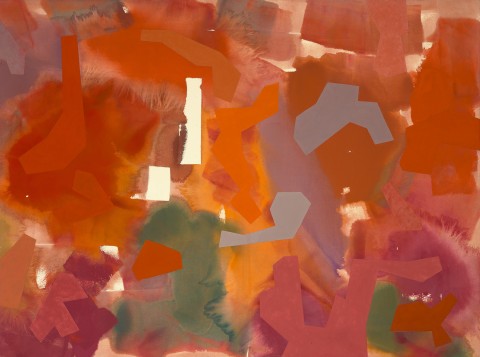PARADISE POINT, 1976
JOHN PEART
synthetic polymer paint on canvas
170.5 x 231.0 cm
signed, dated and inscribed with title verso: “PARADISE POINT” / 1976 / John Peart
Watters Gallery, Sydney
Tolarno Galleries, Melbourne
The National Australia Bank Art Collection, acquired from the above in 1976 (label attached verso)
Probably: John Peart, Watters Gallery, Sydney, September 1976
The Seventies: Australian Paintings and Tapestries from the Collection of National Australia Bank, National Gallery of Victoria, Melbourne, 15 October – 28 November 1982
John Peart – Paintings 1964 – 2004, Campbelltown Arts Centre, Sydney, 2005 – 2006, and touring to Drill Hall Gallery, Melbourne; Australian National University, Canberra; Lawrence Wilson Art Gallery, University of Western Australia, Perth; Burnie Regional Art Gallery, Tasmania; and Campbelltown City Bicentennial Art Gallery, New South Wales
Faerber, R., ‘Less says More’, The Australian Jewish Times, Sydney, 2 September 1976, p. 14
Lindsay, R., The Seventies: Australian Paintings and Tapestries from the Collection of National Australia Bank, The National Bank of Australasia, Melbourne, 1982, pl. 72, p. 85 (illus.)
Porter, R., John Peart – Paintings 1964 – 2004, Campbelltown Arts Centre, Sydney, 2004, pp. 38 (illus.), 72
Frost, J., 'John Peart: still exploring', Artist Profile, Sydney, issue 17, 2011, p. 74
John Peart was perhaps Australia’s most consistent abstract painter, exhibiting loyally at Sydney’s Watters Gallery from the age of 19 until his untimely death in 2013, mercifully before Watters itself ceased operations. Originally from Brisbane, Peart moved to Sydney in the early 60s, during which time he won several art prizes and works acquired for public collections, before embarking on a study tour of the UK, Europe and America, from 1969 – 1972. Upon his return, Peart exhibited selections of large abstract paintings alongside those painted more recently in Sydney, first at Canberra’s Abraxas Gallery in July 1976, at Watters’ in September 1976, and then in Melbourne’s Realities gallery in April in 1977.
Paradise Point, 1976 is a lyrical and diaphanous stain painting, made of a mist of vibrant acrylic paint in rich ochres, mauves and misty greens shifting across the vast surface. The amorphous flow of translucent washes pooling and bleeding into one another is broken by the hard lines of Peart’s overlaid floating shapes of solid colour. This sudden punctuation and alternation gives a dynamic rhythm to Paradise Point. Intensity and pictorial energy are key to Peart’s practice, and constant experimentation and philosophical interrogation enabled his pursuit of these qualities in his work. This process of concealing and revealing he described as an ‘evolving or active superimposed ground’, where background and foreground are not easily defined.1
Peart’s local form of post-painterly abstraction had eclectic influences, ranging from the works of reclusive stalwart Ian Fairweather to the Colour Field works of Americans Morris Louis and Kenneth Noland (seen in the exhibition Two Decades of American Painting, at the Art Gallery New South Wales in 1967). In the early 1960s, Peart read the philosophy of Advianta Vedanta and The First and Last Freedom (1954), by renowned Hindu Tantric teacher Jiddu Krishnamurti – their mystic teachings, in particular those relating to the search for ‘irreducible truth’ through the enlightened mind.2 These teachings were fresh when Paradise Point was painted, as Peart stopped in India on his return to Australia in 1972, the artist inspired to now imagine the pictorial space as an inner landscape for the mind’s eye to roam.3
In an artist’s statement from 1982, Peart explained the tongue-in-cheek title he gave this painting, relating at once to his own deeply subjective painting practice and the posh waterfront suburb of the Gold Coast by the same name: ‘The title Paradise Point reminds me both of the transcendental and the mundane. It represents partly the euphoria aroused in me by the finished painting and partly real estate jargon.’4
1. Peart, cited in Van Nunen, L. ‘Patterns of Experience. Sydney Abstraction’ in Brought to Light II, Contemporary Australian Art 1966 – 2006, Queensland Art Gallery, 2007, p. 38
2. ibid, p. 35
3. Peart, cited in The Challenge of Landscape, New England Regional Art Museum, December 1987
4. Peart, 1982, cited in Lindsay, R., The Seventies: Australian paintings and tapestries from the collection of the National Bank of Australia, National Bank of Australasia, Melbourne, 1982, p. 85
LUCIE REEVES-SMITH
